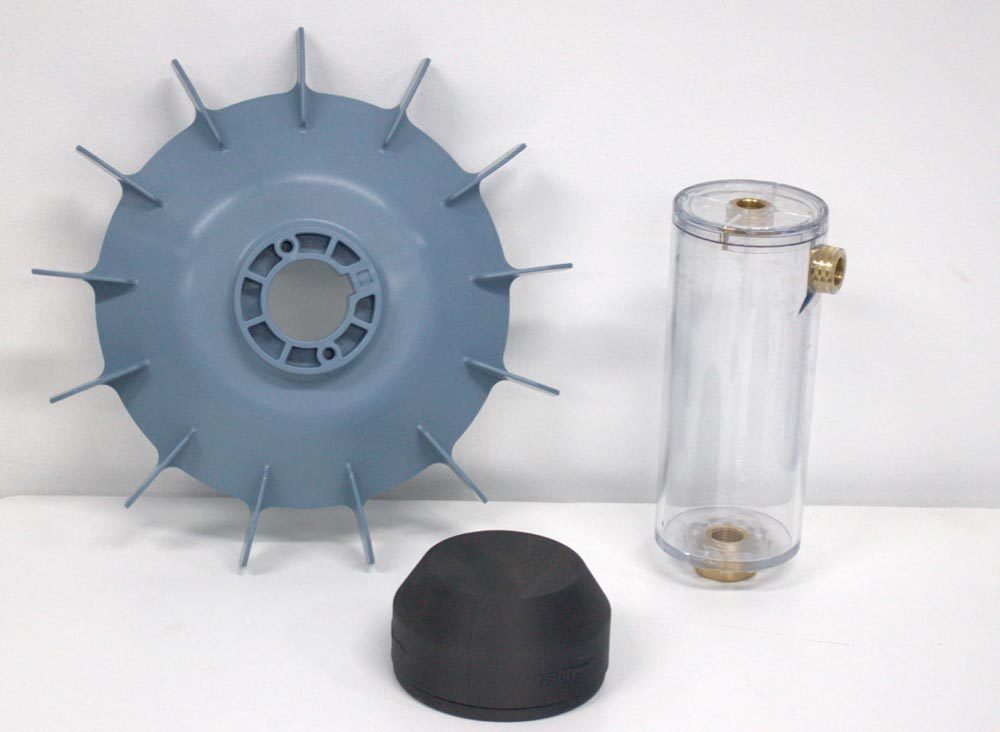Designing Plastic Components for Power Transmission Engineers
Figure 1—Sumitomo Cyclo Cooling Fan (left). Sumitomo Safety Cover (center). Sumitomo Oil Fill Cup (right).
Steel, iron, and aluminum are the dominant materials in the mechanical power transmission industry for good reason: high power density requires the high strength and stiffness of metallic materials. Plastics, however, offer valuable features that should be utilized for good gearbox design. Their low density, low cost, and corrosion resistance properties are ideal for low-stress applications such as fans and covers; transparent plastics are ideal for oil expansion tanks to aid operators in visualizing oil level and appearance from varying distances; high-strength plastics can be used as couplings between metallic components to eliminate fretting wear. Despite their value, plastics are still used infrequently enough in the gear industry that engineers often mistakenly design plastic components as if they were metallic.
Designing plastic components has never been easier. Guides to the basic concepts of plastic design, such as wall thickness, draft, ribbing, etc. are readily available, and fully automated design analysis of a component can be generated at many rapid manufacturing websites. While these resources allow anyone to design a manufacturable plastic component easily, they typically don’t guide how a plastic component might interact within an assembly or environment.
Plastic materials have unique interactions that should be considered before design finalization. As noted herein, some common pitfalls should be avoided and mitigated during the first iteration of a plastic prototype design to maximize success.
Thermal Expansion
Thermal expansion is a common consideration with metallic components when designing press fits, setting bearings, etc. But consider that plastic materials typically have a thermal expansion rate 5 to 10 times higher than steel: this can cause some issues. When plastic components operate on a shaft or within a bore, resultant fits should be calculated. Furthermore, plastic thermal expansion rates are often high enough that dimensional change due to temperature should be included in tolerance analyses or “stack-ups” to ensure the intended final fit. For example, depending on the specific grade of plastic, a 50 mm long component made of Nylon 66 will expand up to 0.25 mm when undergoing a 50°C temperature rise. Thermal expansion could be contributing to the tolerance stack-up just as much as the tolerance itself! When analyzing thermal expansion, it’s vital to ensure data accuracy: use the actual data sheets for the chosen material or standardized sources like CAMPUS (campusplastics.com), as material properties of plastics can vary wildly even within the same polymer family (Ref. 1).
Water Absorption
Plastic components are injection molded, 3D-printed, or otherwise manufactured with the raw material completely dry. After the component is released from the mold, it begins absorbing moisture from the ambient air, until it achieves equilibrium with the environment. This is the state at which plastic components are physically measured, and mechanical properties such as strength and hardness are reported. However, if a component’s operating environment has higher moisture content, e.g., it’s submerged in water or an environment with heavy splashing, the plastic will absorb more water. This additional water content impacts the component’s mechanical properties and causes it to swell physically. Most plastics only change slightly due to this phenomenon, but many families of Nylon (PA) are affected significantly, in some cases growing as much as 1 percent. Referencing the previous Nylon example, the 50 mm long Nylon 66 component could grow 0.5 mm from moisture content alone. This can cause similar issues to thermal expansion and needs to be accounted for by choosing the right material in applications that may experience high moisture content (Ref. 2).
Stress Relaxation
Plastic components undergo a phenomenon known as stress relaxation (not to be confused with creep). When a plastic component is subjected to constant strain, the internal stress in the plastic will reduce over time. This has several effects, but the most common application of stress relaxation is in the bolted joint. Bolts generally stay tight because opposing internal stresses within the bolt and the bolted members cause resultant forces on the threads, which then stay in place due to frictional forces. However, since plastics undergo stress relaxation, a traditional bolted joint with plastic members will lose its axial stress over time, and thus lose friction in the threads, allowing the bolt to loosen. Fastening a plastic component generally requires the use of compression limiters or thread-forming screws. Compression limiters are metal tubes inserted into the component to act as the bolted member for standard fasteners (see Figure 2). Thread-forming screws for plastic are specially designed to retain their clamping force despite stress relaxation (Ref. 3).

Figure 2—Example of compression limiter use.
Knit and Meld Lines
Plastic components are injection molded by forcing molten plastic to flow through a mold under high pressure. Since the plastic is in a liquid state, the long polymer molecules intermix as they flow, and remain entangled when they solidify. This creates much of the component’s material strength since molecules share loads over many intertwined neighbors. In a plastic component with a hollow feature such as a hole, molten plastic must flow around the hole, splitting into two fronts that meet on the opposite side. When the two fronts combine into a single flow front, the meeting point is called a “meld line;” when the flow fronts coincide at the end of the mold, the meeting point is called a “knit line” (see Figure 3). At knit and meld lines there is significantly less intermixing of molecules, and thus the strength at the knit line may be much lower than the rest of the material. This is especially pronounced using brittle materials or materials including glass fiber reinforcement, where the strength at a knit or meld line can be less than half that of the general material. Thus, when designing hollow components, one should be especially aware of how the mold will fill, to ensure that knit lines don’t form in critical areas (Ref. 4).

Figure 3—Meld and knit line examples.
Conclusion
Plastic components are used in the power transmission industry, but they certainly aren’t incorporated as often as they could be. Plastics offer low cost, low weight, and feature benefits that can’t be attained with metals. When designing a supporting feature, consider utilizing a plastic design, keeping in mind the unique design parameters that plastics demand. Use an online plastic design guideline or tool such as those available from Xometry (xometry.com) or ProtoLabs (protolabs.com) to ensure that a component is manufacturable and keep the above concepts in mind when ensuring the component is compatible with its assembly and environment.

References
1. McKeen, L. (2014). The Effect of Temperature and Other Factors on Plastics and Elastomers. Norwich, NY: William Andrew.
2. Monson, L., Braunwarth, M., & Extrand, C. (2008). Moisture absorption by various polyamides and their associated dimensional changes. Journal of Applied Polymer Science, Vol. 107, No. 1; pp. 355-363.
3. Ward, I., & Sweeney, J. (2012). Mechanical Properties of Solid Polymers (3. Aufl. ed.). New York: Wiley.
4. Criens, R. (1986). Impact strength of knit-lines in injection moulded parts. Materials Chemistry and Physics, Vol. 14, No. 1; pp. 69-83.







